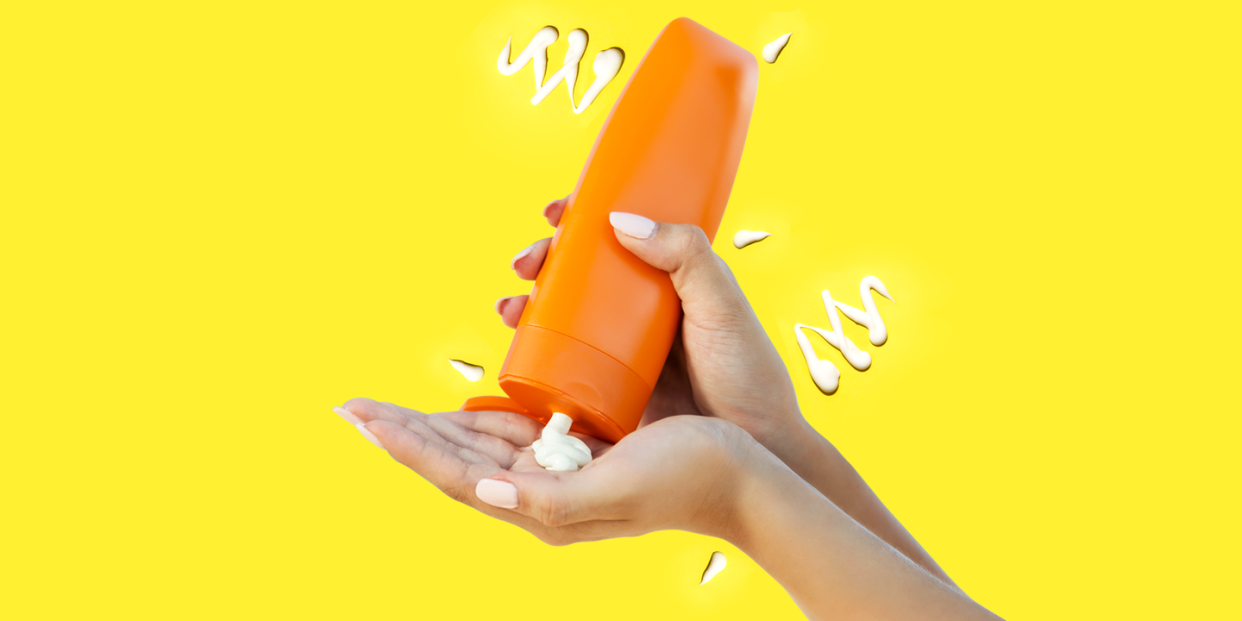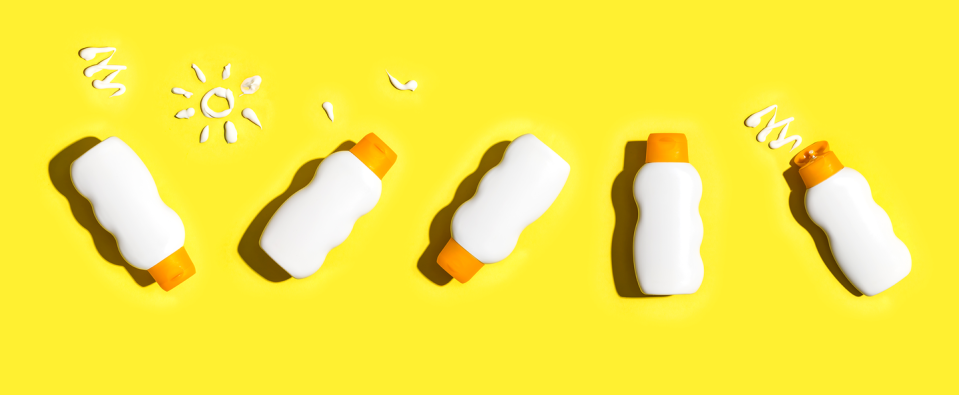In Case You Didn't Know: You Definitely Have to Wear Sunscreen Indoors

"Hearst Magazines and Yahoo may earn commission or revenue on some items through the links below."
You’re a smart cookie, and an in-the-know adult: We don’t need to tell you why you should wear sunscreen. (Okay, we'll remind you: wrinkles, brown spots, and yes, skin cancer ….) But still, even the most knowledgable grown-ups are often confused about how much sunblock to use, when to put it on, how often to reapply it, and so on. We talked to Dendy Engelman, MD, a board-certified dermatologist practicing in New York City and a spokesperson for The Skin Cancer Foundation, to get science-based answers to some top sunscreen questions.
First, what's the right level of SPF to use?
“The SPF should be 15 or higher — ideally, 30 or higher if you’ll be spending extended time outdoors,” says Dr. Engelman. “Be sure the sunscreen says ‘broad spectrum’ on the label, which means it protects against UVA and UVB rays.” She adds, “Look for products that have earned The Skin Cancer Foundation’s Seal of Recommendation to be sure a product is safe and effective. There are many different sunscreen and cosmetic items that have our seal.”
Okay, now how much sunscreen should I use?
Almost no one uses as much as they should, says Dr. Engelman. “To achieve the SPF reflected on a bottle of sunscreen, you should use approximately two milligrams of sunscreen per square centimeter of skin,” she explains. So how does that translate into an amount you can eyeball? “This is about the equivalent of a shot glass full, or about two tablespoons,” she says. “For the face alone, a nickel-sized dollop should be applied. And if you’re using a spray, apply until an even sheen appears on the skin." Remember that sunscreen needs to be reapplied every two hours, or more often after swimming, heavy perspiration, or toweling off.
Do I need to apply sunscreen before I go outside?
Chemical sunscreen, which is absorbed into the skin, needs to be applied 30 minutes before going outdoors to let the ingredients fully bind to the skin, says Dr. Engelman. Physical sunscreens take effect immediately and can be applied right before sun exposure. “And rub it in until you can’t see the product!” she says. Remember the two hour rule: “If you apply sunscreen an hour before heading out, you need to reapply it an hour after you get outside.”
What are the spots on the body that people often miss?
“Skin cancers can show up on any part of the body, even those not exposed to UV rays,” says Dr. Engelman. “But people tend to forget to apply sunscreen on the tips and back of the ears, exposed scalp, back of the neck, around the eyes, and the tops of the hands and feet.” The best way to make sure you get full coverage? “Apply sunscreen before you get dressed, and then reapply to all exposed skin,” she says.

What about my scalp and lips?
Hair does help shield the scalp from the sun’s rays to some extent, says Dr. Engelman. “However, you need more protection than that — especially if your hair is thin. About 10% of melanomas occur on the scalp, so it’s important to take extra precautions by wearing hats and applying sunscreen." There are some products formulated especially for the part in your hair and the rest of your scalp, that won’t leave residue.
Lips, the lower lip especially, "are highly susceptible to skin cancer because they’re also exposed to the sun every day and are one of the most common sites for basal cell and squamous cell carcinomas,” says Dr. Engelman. “Choose a lip balm — or a sunscreen stick designed specifically for the lips — with an SPF of 15 or higher.”
When should I use water-resistant sunscreen?
“Water-resistant” and “very water-resistant” formulas are good for hot days or while playing sports, because they’re less likely to drip into your eyes when you sweat, says Dr. Engelman. “However, these may not be as good for everyday wear. They may be stickier and don’t go on as well under makeup.”
Are moisturizers or makeup with SPF safe?
Many moisturizers have ingredients that make the products SPF 15 or greater, "which is sufficient when you’re doing everyday activities with a few minutes here and there in the sun,” says Dr. Engelman. “However, if you work outside or spend a lot of time outdoors, you need stronger — SPF 30 or higher — water-resistant sunscreen that holds together on your skin.” Using a foundation or primer with sunscreen ingredients is a great way to bump up your sun protection, she adds, but you shouldn’t rely on these products for adequate sun protection. “Most cosmetic formulas lack enough protection against UA rays. For optimal coverage, apply sunscreen under your makeup. Also: Using two products that are each SPF 15 does not equal an SPF 30 product!”
What goes on first: Sunscreen or moisturizer?
Facial sunscreen has emollients and other oils that can be effective to deliver moisturization and hydration,” explains Steven Q. Wang, M.D., a board-certified dermatologist at Memorial Sloan-Kettering Cancer Center. “However, in the winter, I recommend using both sunscreen and a facial moisturizer, especially if you have very dry skin.” Here's a cardinal rule of applying skin care: always put your thinnest products on first, and layer on the rest in order of thickness for optimal absorption. If you opt for a two-step sunscreen-and-moisturizer combo instead of a moisturizer made with SPF, apply your normal moisturizer first, then layer sunscreen (with an SPF of 30 or higher) over it. If you're looking for a higher level of SPF like an SPF 50, your best bet is a face sunscreen, as few effective moisturizers contain higher levels of sunscreen.
Will sunscreen dry out my skin?
Maybe. “Some sunscreens may also contain alcohol which tends to dry out skin,” explains Dr. David Lortscher, board-certified dermatologist and CEO of Curology. “Look for formulas without alcohol to avoid dryness or irritation.” Check out the ingredients label for culprits: drying ethanol can sometime be written as "SD alcohol" (specially denatured alcohol) or "alcohol denat." But here's a loophole: if you see cetyl, stearyl or cetearyl alcohol, don't panic. These are actually fatty alcohols that can act like emollients, softening the skin.
Do I need to use sunscreen indoors?
Yes, you should wear it daily, Dr. Engelman explains. “Windows — at home, on trains, planes, and cars — allow UVA rays to pass through."
Remember: While sunscreen is a crucial step for sun protection, it’s not enough on its own. Take these extra precautions: Seek the shade whenever possible, and wear sun-safe clothing, a wide-brimmed hat, and UV-blocking sunglasses, says Dr. Engelman. Head to a shady area during peak ray intensity, 10 AM to 4 PM. And walk on the shady side of the street when you’re out and about.
You Might Also Like

